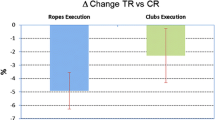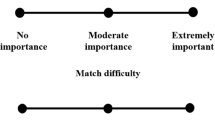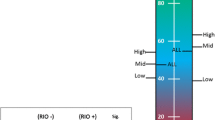Abstract
Altered neural mechanisms implying autonomic functioning have been described related to anxiety. Pre-competitive stress may be considered as an anxiety-state associated with disorders (i.e. somatic and cognitive alterations, and self-confidence worsening) that severely impair sport performance, conditioning short-lasting strength-related disciplines like BMX. From the psychological perspective, coaches use questionnaires like CSAI-2R to identify these alterations. However, with the emergence of psycho-physiological and non-linear approaches, recent studies suggest that HRV analysis provides a non-invasive tool to assess them. Hence, our purpose was to analyze how BMX competition affects subjective perception of anxiety, and if this emotional alteration is reflected in HR dynamics, analyzed both linear and nonlinearly, exploring the evolution of this relationship in a 2-day competition. Eleven male athletes from the BMX Spanish National Team were assessed from baseline HRV the morning of a training session (rT) and on two successive days of competition (rC1 and rC2), repeating HRV recording with CSAI-2R 20 min prior to training (aT) and competition (pre-competitive: aC1 and aC2). Repeated measures MANOVA showed significant vagal slow-down responses in aC1 and aC2 comparing not only with aT, but also comparing with rT, rC1 and rC2, coinciding with significant greater scores for the somatic and cognitive anxiety (SA and CA) in aC1 and aC2 versus aT. Pearson analysis showed a large and positive correlation between α1 and SA in C1, and close to it between SampEn and CA in aC2; both were confirmed by Bland–Altman chart analysis. Our results confirm that HRV analysis provide a complementary tool to assess competitive pressure.





Similar content being viewed by others
References
Andrade Fernandez EM, Lois Rio G, Arce Fernandez C (2007) Psychometric properties of the Spanish version of the Revised Competitive State Anxiety Inventory-2 with athletes. Psicothema 19(1):150–155
Berntson G, Bigger J Jr, Eckberg D, Grossman P, Kaufmann P, Malik M, Nagaraja H, Porges S, Saul J, Stone P (1997) Heart rate variability: origins, methods, and interpretive caveats. Psychophysiology 34(6):623–648
Blasco-Lafarga C, Martinez-Navarro I, Sisamon ME, Caus N, Yanguez E, Llorens-Soriano P (2010) Linear and nonlinear heart rate dynamics in elderly inpatients. Relations with comorbidity and depression. Medicina (Kaunas) 46(6):393–400
Bornas X, Llabres J, Noguera M, Pez A (2006) Sample entropy of ECG time series of fearful flyers: preliminary results. Nonlinear Dynamics Psychol Life Sci 10(3):301–318
Buchheit M, Al Haddad H, Laursen PB, Ahmaidi S (2009) Effect of body posture on postexercise parasympathetic reactivation in men. Exp Physiol 94(7):795–804. doi:10.1113/expphysiol.2009.048041
Buchheit M, Mendez-Villanueva A, Quod MJ, Poulos N, Bourdon P (2010) Determinants of the variability of heart rate measures during a competitive period in young soccer players. Eur J Appl Physiol. doi:10.1007/s00421-010-1422-x
Cerin E, Szabo A, Hunt N, Williams C (2000) Temporal patterning of competitive emotions: a critical review. J Sports Sci 18(8):605–626
Cervantes Blásquez JC, Rodas Font G, Capdevila Ortis L (2009) Heart-rate variability and precompetitive anxiety in swimmers. Psicothema 21(4):531–536
Cohen J (1988) Statistical power analysis for the behavioral sciences. Lawrence Erlbaum, Hillsdale
Cohen H, Benjamin J, Geva A, Matar M, Kaplan Z, Kotler M (2000) Autonomic dysregulation in panic disorder and in post-traumatic stress disorder: application of power spectrum analysis of heart rate variability at rest and in response to recollection of trauma or panic attacks. Psychiatry Res 96(1):1–13
Cooke A, Kavussanu M, McIntyre D, Ring C (2010) Psychological, muscular and kinematic factors mediate performance under pressure. Psychophysiology 47(6):1109–1118. doi:10.1111/j.1469-8986.2010.01021.x
Cox R, Martens M, Russell W (2003) Measuring anxiety in athletics: The revised competitive state anxiety inventory-2. J Sport Exerc Psychol 25(4):519–533
Davis J, Cox R (2002) Interpreting direction of anxiety within Hanin’s individual zone of optimal functioning. J Appl Sport Psychol 14(1):43–52
Filaire E, Portier H, Massart A, Ramat L, Teixeira A (2010) Effect of lecturing to 200 students on heart rate variability and alpha-amylase activity. Eur J Appl Physiol 108(5):1035–1043
Friedman B (2007) An autonomic flexibility-neurovisceral integration model of anxiety and cardiac vagal tone. Biol Psychol 74(2):185–199
Fuller B (1992) The effects of stress-anxiety and coping styles on heart rate variability. Int J Psychophysiol 12(1):81–86
Gamelin FX, Berthoin S, Bosquet L (2006) Validity of the polar S810 heart rate monitor to measure R-R intervals at rest. Med Sci Sports Exerc 38(5):887–893. doi:10.1249/01.mss.0000218135.79476.9c
Goldberger AL, Amaral LA, Glass L, Hausdorff JM, Ivanov PC, Mark RG, Mietus JE, Moody GB, Peng CK, Stanley HE (2000) PhysioBank, PhysioToolkit, and PhysioNet: components of a new research resource for complex physiologic signals. Circulation 101(23):E215–E220
Gould D, Horn T, Spreemann J (1983) Competitive anxiety in junior elite wrestlers. J Sport Psychol 5(1):58–71
Hagtvet K, Hanin Y (2007) Consistency of performance-related emotions in elite athletes: Generalizability theory applied to the IZOF model. Psychol Sport Exerc 8(1):47–72
Hanin Y (2000) Emotions in sport. Human Kinetics, Champaign
Hanin Y (2003) Performance related emotional states in sport: a qualitative analysis. Paper presented at the FQS: qualitative methods in various disciplines IV: sport sciences
Hanton S, Jones G, Mullen R (2000) Intensity and direction of competitive state anxiety as interpreted by rugby players and rifle shooters. Percept Mot Skills 90(2):513
Hautala A, Mäkikallio T, Seppänen T, Huikuri H, Tulppo M (2003) Short term correlation properties of R-R interval dynamics at different exercise intensity levels. Clin Physiol Funct Imaging 23(4):215–223. doi:10.1046/j.1475-097X.2003.00499.x
Hautala AJ, Karjalainen J, Kiviniemi AM, Kinnunen H, Makikallio TH, Huikuri HV, Tulppo MP (2010) Physical activity and heart rate variability measured simultaneously during waking hours. Am J Physiol Heart Circ Physiol 298(3):H874–H880. doi:10.1152/ajpheart.00856.2009
Hynynen E, Vesterinen V, Rusko H, Nummela A (2010) Effects of moderate and heavy endurance exercise on nocturnal HRV. Int J Sports Med 31(6):428–432. doi:10.1055/s-0030-1249625
Karavirta L, Tulppo M, Laaksonen D, Nyman K, Laukkanen R, Kinnunen H, Häkkinen A, Häkkinen K (2009) Heart rate dynamics after combined endurance and strength training in older men. Med Sci Sports Exerc 41(7):1436
Kiviniemi AM, Hautala AJ, Seppanen T, Makikallio TH, Huikuri HV, Tulppo MP (2004) Saturation of high-frequency oscillations of RR intervals in healthy subjects and patients after acute myocardial infarction during ambulatory conditions. Am J Physiol Heart Circ Physiol 287(5):H1921
Kleine D (1990) Anxiety and sport performance: a meta-analysis. Anxiety, Stress & Coping 2(2):113–131
Lane J, Adcock R, Burnett R (1992) Respiratory sinus arrhythmia and cardiovascular responses to stress. Psychophysiology 29(4):461–470
Lundqvist C, Kentta G, Raglin JS (2010) Directional anxiety responses in elite and sub-elite young athletes: intensity of anxiety symptoms matters. Scand J Med Sci Sports. doi:10.1111/j.1600-0838.2010.01102.x
Mäkikallio TH, Huikuri HV, Mäkikallio A, Sourander LB, Mitrani RD, Castellanos A, Myerburg RJ (2001) Prediction of sudden cardiac death by fractal analysis of heart rate variability in elderly subjects. J Am Coll Cardiol 37(5):1395–1402. doi:10.1016/S0735-1097(01)01171-8
Martens R, Vealey R, Burton D (1990) Competitive anxiety in sport. Human Kinetics, Champaing
Martens E, Smith O, Denollet J (2007) Psychological symptom clusters, psychiatric comorbidity and poor self-reported health status following myocardial infarction. Ann Behav Med 34(1):87–94
Martinmaki K, Rusko H, Kooistra L, Kettunen J, Saalasti S (2006) Intraindividual validation of heart rate variability indexes to measure vagal effects on hearts. Am J Physiol Heart Circ Physiol 290(2):H640–H647. doi:10.1152/ajpheart.00054.2005
Mateo M, Blasco-Lafarga C, Zabala M (2011) Pedaling power and speed production vs. technical factors and track difficulty in bicycle motocross cycling. J Strength Cond Res (In press)
Mauss I, Gross J (2004) Emotion suppression and cardiovascular disease. In: Nyklícek I, Temoshok L, Vingerhoets A (eds) Emotional expression and health advances in theory, assessment and clinical applications. Routledge, UK, pp 61–81
Mellalieu SD, Hanton S, O’Brien M (2004) Intensity and direction of competitive anxiety as a function of sport type and experience. Scand J Med Sci Sports 14(5):326–334. doi:10.1111/j.1600-0838.2004.00389.x
Mellalieu SD, Hanton S, Shearer DA (2008) Hearts in the fire, heads in the fridge: a qualitative investigation into the temporal patterning of the precompetitive psychological response in elite performers. J Sports Sci 26(8):811–824. doi:10.1080/02640410701790787
Mendonca GV, Heffernan KS, Rossow L, Guerra M, Pereira FD, Fernhall B (2010) Sex differences in linear and nonlinear heart rate variability during early recovery from supramaximal exercise. Appl Physiol Nutr Metab 35(4):439–446. doi:10.1139/H10-028
Millar PJ, Rakobowchuk M, Adams MM, Hicks AL, McCartney N, MacDonald MJ (2009) Effects of short-term training on heart rate dynamics in individuals with spinal cord injury. Auton Neurosci 150(1–2):116–121. doi:10.1016/j.autneu.2009.03.012
Millar PJ, Cotie LM, St Amand T, McCartney N, Ditor DS (2010) Effects of autonomic blockade on nonlinear heart rate dynamics. Clin Auton Res. doi:10.1007/s10286-010-0058-6
Montano N, Porta A, Cogliati C, Costantino G, Tobaldini E, Casali KR, Iellamo F (2009) Heart rate variability explored in the frequency domain: a tool to investigate the link between heart and behavior. Neurosci Biobehav Rev 33(2):71–80. doi:10.1016/j.neubiorev.2008.07.006
Mourot L, Bouhaddi M, Gandelin E, Cappelle S, Nguyen N, Wolf J, Rouillon J, Hughson R, Regnard J (2007) Conditions of autonomic reciprocal interplay versus autonomic co-activation: effects on non-linear heart rate dynamics. Auton Neurosci 137(1–2):27–36
Mullen R, Hardy L, Tattersall A (2005) The effects of anxiety on motor performance: A test of the conscious processing hypothesis. J Sport Exerc Psychol 27:212–225
Nunan D, Donovan G, Jakovljevic DG, Hodges LD, Sandercock GR, Brodie DA (2009) Validity and reliability of short-term heart-rate variability from the Polar S810. Med Sci Sports Exerc 41(1):243–250. doi:10.1249/MSS.0b013e318184a4b1
Parrado E, Cervantes J, Pintanel M, Rodas G, Capdevila L (2010) Perceived tiredness and heart rate variability in relation to overload during a field hockey World Cup. Percept Mot Skills 110(3 Pt 1):699–713
Peng CK, Havlin S, Stanley HE, Goldberger AL (1995) Quantification of scaling exponents and crossover phenomena in nonstationary heartbeat time series. Chaos 5(1):82–87. doi:10.1063/1.166141
Penttila J, Helminen A, Jartti T, Kuusela T, Huikuri HV, Tulppo MP, Scheinin H (2003) Effect of cardiac vagal outflow on complexity and fractal correlation properties of heart rate dynamics. Auton Autacoid Pharmacol 23(3):173–179. doi:10.1046/j.1474-8673.2003.00293.x
Pichot V, Busso T, Roche F, Garet M, Costes F, Duverney D, Lacour JR, Barthelemy JC (2002) Autonomic adaptations to intensive and overload training periods: a laboratory study. Med Sci Sports Exerc 34(10):1660–1666. doi:10.1249/01.MSS.0000035993.08625.31
Porges SW (2001) The polyvagal theory: phylogenetic substrates of a social nervous system. Int J Psychophysiol 42(2):123–146. doi:10.1016/S0167-8760(01)00162-3
Porges SW (2003) The Polyvagal Theory: phylogenetic contributions to social behavior. Physiol Behav 79(3):503–513. doi:10.1016/S0031-9384(03)00156-2
Porges SW (2007) The polyvagal perspective. Biol Psychol 74(2):116–143. doi:10.1016/j.biopsycho.2006.06.009
Porges SW (2009) The polyvagal theory: new insights into adaptive reactions of the autonomic nervous system. Cleve Clin J Med 76(Suppl 2):S86–S90. doi:10.3949/ccjm.76.s2.17
Richman JS, Moorman JR (2000) Physiological time-series analysis using approximate entropy and sample entropy. Am J Physiol Heart Circ Physiol 278(6):H2039–H2049
Rushall B (1979) Psyching in sport. Pelham Books, London
Scanlan T, Passer M (1979) Factors influencing the competitive performance expectancies of young female athletes. J Sport Psychol 1:212–220
Scheeringa R, Bastiaansen M, Petersson K, Oostenveld R, Norris D, Hagoort P (2008) Frontal theta EEG activity correlates negatively with the default mode network in resting state. Int J Psychophysiol 67(3):242–251
Schwarz AM, Schachinger H, Adler RH, Goetz SM (2003) Hopelessness is associated with decreased heart rate variability during championship chess games. Psychosom Med 65(4):658–661
Servant D, Logier R, Mouster Y, Goudemand M (2009) La variabilité de la fréquence cardiaque. Intér ts en psychiatrie L’Encéphale 35(5):423–428
Som A, Sánchez-Muñoz C, Zabala M, Mateo M, Guzmán JF (2009) Ansiedad y autoconfianza en los pilotos de la selección nacional de BMX durante las mangas del Campeonato de Europa y del Mundo. Cultura, Ciencia y Deporte 5(Supp 13):S155
Sonstroem R (1984) Exercise and self-esteem. Exerc Sport Sci Rev 12(1):123
Tarvainen MP, Ranta-Aho PO, Karjalainen PA (2002) An advanced detrending method with application to HRV analysis. IEEE Trans Biomed Eng 49(2):172–175. doi:10.1109/10.979357
Thayer J, Friedman B, Borkovec T, Johnsen B, Molina S (2000) Phasic heart period reactions to cued threat and nonthreat stimuli in generalized anxiety disorder. Psychophysiology 37(03):361–368
Troubat N, Fargeas-Gluck MA, Tulppo M, Dugue B (2009) The stress of chess players as a model to study the effects of psychological stimuli on physiological responses: an example of substrate oxidation and heart rate variability in man. Eur J Appl Physiol 105(3):343–349. doi:10.1007/s00421-008-0908-2
Tulppo M, Kiviniemi A, Hautala A, Kallio M, Seppanen T, Makikallio T, Huikuri H (2005) Physiological background of the loss of fractal heart rate dynamics. Circulation 112(3):314
Vanderlei L, Pastre C, Júnior I, de Godoy M (2010) Fractal correlation of heart rate variability in obese children. Auton Neurosci 155(1–2):125–129
Veldhuijzen Van Zanten J, De Boer D, Harrison L, Ring C, Carroll D, Willemsen G, De Geus E (2002) Competitiveness and hemodynamic reactions to competition. Psychophysiology 39(06):759–766
Weinberg R, Genuchi M (1980) Relationship between competitive trait anxiety, state anxiety, and golf performance: A field study. J Sport Psychol 2(2):148–154
Weippert M, Kumar M, Kreuzfeld S, Arndt D, Rieger A, Stoll R (2010) Comparison of three mobile devices for measuring R-R intervals and heart rate variability: Polar S810i, Suunto t6 and an ambulatory ECG system. Eur J Appl Physiol 109(4):779–786. doi:10.1007/s00421-010-1415-9
Wilson M, Smith N, Holmes P (2007) The role of effort in influencing the effect of anxiety on performance: Testing the conflicting predictions of processing efficiency theory and the conscious processing hypothesis. Br J Psychol 98(3):411–428
Woodman T, Hardy L (2001) Stress and anxiety. In: Singer R, Hausenblas H, Janelle C (eds) Handbook of Research on Sport Psychology. Wiley, New York, pp 290–318
Matheson H, Mathes S (1991) Influence of performance setting, experience and difficulty of routine on precompetition anxiety and self-confidence of high school female gymnasts. Percept Mot Skills 72(3 Pt 2):1099
Yeragani V, Mallika Mallavarapu B, Radhakrishna R, Tech M, Tancer M, Uhde T (2004) Linear and nonlinear measures of blood pressure variability: increased chaos of blood pressure time series in patients with panic disorder. Anxiety 19(2):85–95
Zabala M, Sanchez-Muñoz C, Mateo M (2009) Effects of the administration of feedback on performance of the BMX cycling gate start. J Sports Sci Med 8(3):393–400
Acknowledgments
Special thanks to the Cycling Federations of Valencia and Andalusia (Spain), especially to the coaches Alvaro Navarro Rivas, Antonio Pérez Montava and Antonio Som Castillo. We also thank Elena Sarabia (Pablo de Olavide University, Seville, Spain) for reviewing previous versions of the manuscript.
Conflict of interest
The present manuscript has been partially supported by Valencian and Andalucian Cycling Federations, jointly with the Spanish Cycling Federation, who has given consent to publish the results.
Author information
Authors and Affiliations
Corresponding author
Additional information
Communicated by Dag Linnarsson.
Rights and permissions
About this article
Cite this article
Mateo, M., Blasco-Lafarga, C., Martínez-Navarro, I. et al. Heart rate variability and pre-competitive anxiety in BMX discipline. Eur J Appl Physiol 112, 113–123 (2012). https://doi.org/10.1007/s00421-011-1962-8
Received:
Accepted:
Published:
Issue Date:
DOI: https://doi.org/10.1007/s00421-011-1962-8




